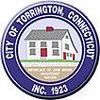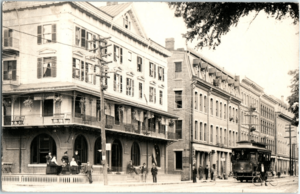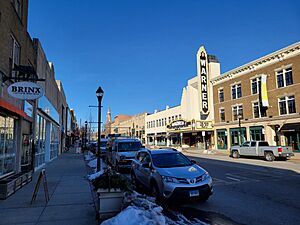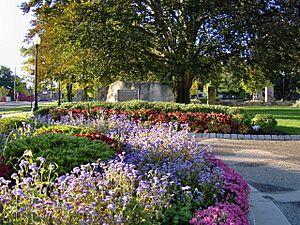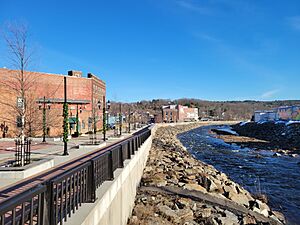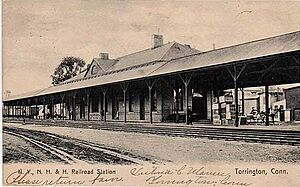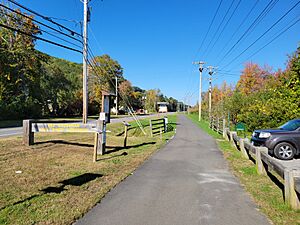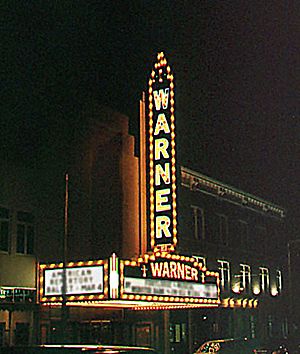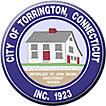Torrington, Connecticut facts for kids
Quick facts for kids
Torrington
|
||
|---|---|---|
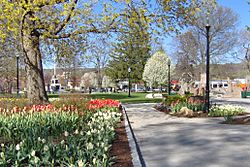
Coe Memorial Park
|
||
|
||
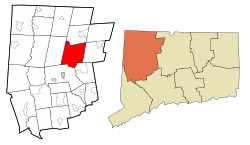 Litchfield County and Connecticut Litchfield County and Connecticut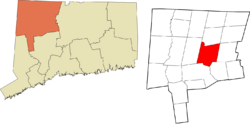 Northwest Hills Planning Region and Connecticut Northwest Hills Planning Region and Connecticut |
||
| Country | ||
| U.S. state | ||
| County | Litchfield | |
| Region | Northwest Hills | |
| Incorporated (town) | 1740 | |
| Incorporated (city) | 1923 | |
| Government | ||
| • Type | Mayor-council | |
| Area | ||
| • Total | 40.33 sq mi (104.46 km2) | |
| • Land | 39.77 sq mi (103.01 km2) | |
| • Water | 0.56 sq mi (1.44 km2) | |
| Elevation | 541 ft (165 m) | |
| Population
(2020)
|
||
| • Total | 35,515 | |
| • Density | 893/sq mi (344.8/km2) | |
| Time zone | UTC−5 (EST) | |
| • Summer (DST) | UTC−4 (EDT) | |
| ZIP code |
06790
|
|
| Area code(s) | 860/959 | |
| FIPS code | 09-76500 | |
| GNIS feature ID | 0211514 | |
| U.S. Highways | ||
| State Routes |  |
|
Torrington is the biggest city and has the most people in Litchfield County, Connecticut, United States. It's also the main city of Greater Torrington, which is a large "micropolitan area" – meaning it's a city and its nearby towns that are connected. In 2020, about 35,515 people lived here. The city is located about 23 miles west of Hartford.
Torrington used to be a town known for its factories, like many other towns along the Naugatuck River Valley. Today, downtown Torrington is home to the Nutmeg Conservatory for the Arts, where young people learn to be ballet dancers. Their performances often take place at the Warner Theatre, a beautiful 1,700-seat building that opened in 1931 as a cinema. Downtown also has KidsPlay, a children's museum that started in 2012.
The city has two radio stations: WAPJ 89.9 FM and WSNG 610 AM. You can also read news from two daily newspapers: Republican-American and The Register Citizen. Charlotte Hungerford Hospital is an important place for healthcare in the area. In 2008, a business magazine called Torrington one of the top "Dreamtowns" to live in!
Contents
Torrington's Story: A Look Back
Torrington was first settled in 1735 by Ebenezer Lyman, Jr. The downtown area was once called Wolcottville, named after the Wolcott family who had several governors from Connecticut. The first settlers lived on the hills west of the Naugatuck River, where they built the first school, church, store, and tavern. Later, people settled on the eastern hill, Torringford, because it had good farmland. Torrington officially became a town in October 1740. It was named after a town called Torrington in Devon, England.
The fast-moving waters of the Naugatuck River were perfect for powering early factories in the 1800s. When Frederick Wolcott built a woolen mill in 1813, the town grew quickly. Many people came to work at the mill, which created a need for more shops, services, and homes.
In 1834, Israel Coe and Erastus Hodges started building two brass mills on the Naugatuck River. This was the start of the brass industry in Torrington, which then spread throughout the whole Naugatuck Valley. In 1849, the Naugatuck Valley railroad was finished. This connected Torrington to other towns, making it easier to travel and helping more factories grow. Soon, Torrington was making many different metal products, like needles, brass, and even bicycles.
More and more people came to Torrington to work in the growing factories. Many immigrants from England, Ireland, and Germany arrived in the 1800s. Between 1880 and 1920, Torrington's population jumped from 3,000 to 22,000 as people from southern and eastern Europe, like Poland, the Czech Republic, Slovakia, and Italy, moved here. Torrington officially became a city in 1923.
In 1955, a huge flood caused a lot of damage to the downtown area when Hurricanes Connie and Diane made local rivers overflow. Torrington is also home to several state parks, including the popular Burr Pond State Park. In 1851, Milo Burr built a dam to create the pond, which was used to power tanneries and sawmills. Burr Pond became a state park in 1949. The pond is a great place for fishing, with different types of fish like bass and perch.
Gail Borden, who invented a way to preserve milk by evaporating and condensing it, built the world's first condensed milk factory here in 1856. This new milk product was very helpful, especially for the Union Army during the Civil War. The factory burned down in 1877. A special marker shows where it used to be.
Torrington is the birthplace of John Brown, a famous abolitionist who fought against slavery. His birthplace burned down in 1918. The Torrington Historical Society now owns the land and plans to create trails and improve the area for visitors.
Making Downtown Better
Torrington is working on plans to make its downtown area even better. The goal is to attract more residents and visitors to enjoy the shops and cultural spots. These plans are still being discussed. The city will receive money to improve Main Street and the downtown area, including new sidewalks.
Here are some ideas that have been talked about:
Coe Memorial Park: A Beautiful Place
The historic Coe Memorial Park was restored and improved in 2004. The goal was to make it look like a Victorian walking park, similar to how it was when it was first given to the town in 1906. This included new paths and moving memorials. In 2005, a talented gardener named Gwenythe B. Harvey helped redesign and improve the park's gardens. Coe Memorial Park's Botanical Gardens has become a popular place for tourists to visit.
New Shops and Spaces
Torrington hopes to bring many different kinds of shops to its downtown. Empty buildings might be turned into new shops, offices, and homes. There was a plan to build a national clothing store or bookstore where the Kelley Bus Company used to be. This plan meant taking down the old Torrington railroad station, which some people thought was important to history. However, the 113-year-old station was taken down in 2011 because it was considered unsafe. The historical society was able to save some parts, like the ticket window.
Getting Around Downtown
A parking garage might be built in the middle of downtown. The city's parking lot next to the Torrington Library would also be used for downtown parking. The plan for downtown also focuses on making it easy for people to walk. This means building brick sidewalks with trees, benches, and bike racks along Main Street.
Roads and Traffic Flow
To help with traffic, the city plans to change the main downtown intersection (Main Street/Water Street/East Main Street) into a simple "+" shape. The city also expects to make Main Street a one-way road with parking on one side. The nearby Prospect Street would also become a one-way road with traffic going the other way.
Where is Torrington?
Torrington covers about 40.4 square miles (104.6 square kilometers). Most of this area is land, and a small part is water.
The eastern and western edges of the city are on top of hills, while the downtown and central parts are in the Naugatuck River Valley. This means you can get some amazing views of the city lights from the higher areas. If you want to cross the city from east to west, you usually have to drive down into the valley and then back up the other side.
Neighborhoods in Torrington
- Burrville
- Drakeville
- Newfield
- Torringford (part of which is a historic area called the Torringford Street Historic District)
- Downtown Torrington
- West Torrington
- Wrightville
Torrington's Weather
Torrington has a climate with big changes in temperature throughout the year. Summers are warm to hot and often humid, while winters are cold, sometimes very cold. This type of weather is called a humid continental climate.
How to Get Around

Three main highways meet in downtown Torrington: Route 8, Route 4, and Route 202. Other important roads include Route 183 and Route 272. You can also get around the city using buses from the Northwestern Connecticut Transit District. There's also a connecting bus service to Waterbury.
For freight, there's a train service operated by the Naugatuck Railroad that goes up to Torrington. If you need to fly, Bradley International Airport (BDL) in Windsor Locks is the closest major airport.
City Life and Services
Fun at Main Street Marketplace
The Main Street Marketplace (MSMP) started in 2009. The idea was to create an event that would bring families downtown and help local businesses. Since then, MSMP has become very popular, bringing in about 3,000 visitors each night! It features 40–45 exhibitors, 15–20 food vendors, and many different kinds of performers.
It used to be a multi-week event held on a specific weeknight during the summer, from 5 to 9 o'clock. Main Street would be closed off, and the marketplace would stretch from Water Street to Alvord Street.
Sports and Fun Events
Baseball Teams
Fuessenich Park in Torrington has been home to professional and college baseball teams.
The Torrington Titans played in a college summer baseball league called the Futures Collegiate Baseball League. They were very popular and even won their division in 2010. However, the Titans did not play after the 2016 season.
Before the Titans, the Torrington Twisters were part of the New England Collegiate Baseball League from 1997 to 2008. They often did well in their division. The Twisters also hosted the league's All-Star Game twice.
A professional baseball team called the Torrington Braves played in the city for one season in 1950.
Running Events
The Torrington Road Race is a five-mile (8 km) run that happens in August. It starts at Coe Memorial Park and goes through different parts of the city. This race began in 1972 and attracts runners from all over Connecticut and nearby states. The fastest time for the race was 24 minutes and 22 seconds, set by Evance Rotich in 2008. Chris Chisholm has won the men's race six times, and Anne Curi-Preisig has won the women's race six times. Rosa Moriello is the only woman to win the entire race, finishing in 27 minutes and 55 seconds in 2012.
High School Sports
Torrington High School offers many sports, including football, soccer, volleyball, basketball, baseball, softball, tennis, and golf. They also have cheerleading and dance teams.
Since 1998, the Torrington High School Athletic Hall of Fame has honored over 100 great athletes and coaches. In 2006, the Torrington High School Men's Basketball team won their first Connecticut State Championship since 1944!
Historic Places to See
Torrington has many buildings and areas that are listed on the National Register of Historic Places, meaning they are important and protected. These include:
- Migeon Avenue Historic District
- Paugnut Forest Administration Building
- Skee's Diner
- South School
- Torringford Street Historic District
- Torrington Fire Department Headquarters
- Villa Friuli
- Warner Theatre
- Warrenton Woolen Mill
- Water Street Historic District
Famous People From Torrington
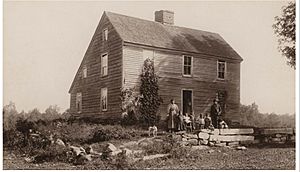
Many notable people have connections to Torrington:
- John Brown (1800–1859), an abolitionist who fought against slavery, was born here.
- Josiah Bunting III (born 1939), an author, educator, and soldier.
- W. G. Curtis (1857–1913), who founded the town of Torrington, Wyoming, named it after his former home here.
- Bill C. Davis (1961–2021), a playwright.
- Dick Ebersol (born 1947), a chairman at NBC Universal Sports.
- Frank Fixaris (1934–2006), a sportscaster from Maine.
- Aline Huke Frink (1904–2000), a mathematician and professor.
- Ellen Maria Huntington Gates (1835–1920), a hymn writer and poet.
- Horace Holley (1887–1960), an important follower of the Baha'i Faith.
- Samuel John Mills (1783–1818), a Congregationalist missionary.
- Wendell Phillips Norton Sr. (1861–1955), an inventor.
- Lyman Cornelius Smith (1850–1910), who founded the L.C. Smith & Brothers Typewriter Company (later Smith-Corona Company).
- William L. Shirer, author of “The Rise and Fall of the Third Reich,” lived here.
- Steven Strogatz, a mathematician and science popularizer.
- Karl Swenson (1908–1978), an actor.
- Tracey Thurman, a victim of domestic violence who brought national attention to the issue in 1985.
- Patricia Wald (1928–2019), the first female judge of the Washington, D.C., circuit court.
- Jordan Williams (born 1990), a basketball player.
- Jocko Willink (born 1971), a former US Navy SEAL Lt. Commander, author, and podcaster.
Images for kids
See also
 In Spanish: Torrington (Connecticut) para niños
In Spanish: Torrington (Connecticut) para niños


